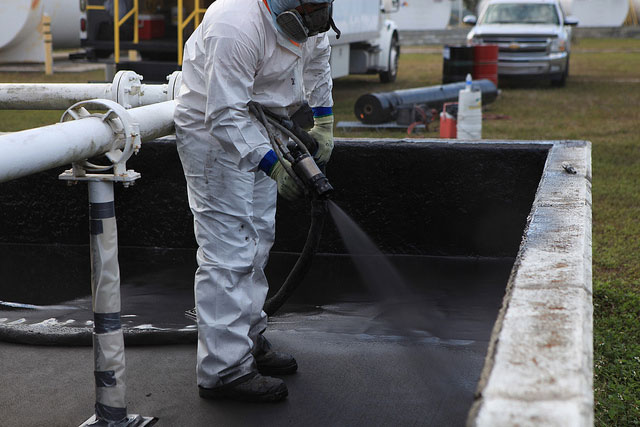When Secondary Containment Coatings Are Primary
It's a common occurrence to switch on the news as well as witness some form of hazardous chemical release right into the waterways, ground, or environment. These hazardous occasions have gathered a much better public worry over the past 25 years, and also social media and camera phones assist to keep them in the forefront.
We made use of to only become aware of the bigger cases that caused the loss of life, an ecological influence on drinking water, or massive catastrophe to wild animals, such as when the Exxon Valdez ran ashore on Royal prince William Audio's Bligh Reef in 1989. Now we are hearing and seeing more such events-- even those of a smaller-scale.
New policies and also regulations have actually enhanced the liability on the chemical customers and also transporters, specifically since they have to take every preventative measure to lessen as well as protect against the unexpected launch of harmful substances into the atmosphere. The security of life and also the environment have to be a primary worry for every single facility proprietor, plant designer, driver, as well as maintenance workers.
There are human mistake, mishaps, and leaking connections, gaskets, and seal failures, yet with proper style as well as hostile preparation for such events, these harmful launches can be reduced.
Secondary Containment Solutions The correct design, construction, as well as maintenance of the secondary containment system within an industrial center is extremely important to including leakages and also spills from the primary storage tanks or vessels. The major objective of a secondary system is to contain the spill up until it can be reduced the effects of, cleaned up, as well as disposed of effectively. A secondary containment structure need to be developed with a high level of chemical resistance to a lesser level than that of the primary system.
Particularly in older facilities, most of these containment frameworks were built from developed concrete because of price of material and convenience of application. Concrete alone is not an ideal product in offering efficient chemical resistance or a dependable barrier for the permeation of a lot of acids and also chemical concentrations. The permeation into the concrete will certainly trigger severe degradation and also fracturing, allowing the acid or caustic substance to leach out and pollute the setting.
Securing the concrete with a chemical immune finish or lining, for that reason, can be a cost-effective way to protect these structures. Before a lining or covering can be used, the concrete must be assessed to determine its condition. The contractor will also need to know what surface area preparation, crack dental filling, chemical resistance, as well as other barriers require to be dealt with to guarantee an appropriate bond and a reliable final product. Possibilities are that if the secondary pit has actually remained in area for some time, anxiety and also clearing up fractures will certainly have created as well as will need to be fixed with a suitable mortar before a lining or finishing can be applied.
Today, engineers and specifiers have a wider variety of materials to choose from relying on numerous factors, including whether the primary storage is an acid, solvent, or caustic, what the focus are, as well as at what temperature levels they are saved. Safety layers as well as linings can vary from thin-film coverings to higher-build fiber. Flake-filled lining systems as well as thick-matte strengthened systems are likewise alternatives. Commonly all these systems will have an epoxy, vinyl-ester, epoxy vinyl-ester, novolac, furan, or polymer concrete chemistry.
Application approach might be done by hand, such as brush, roller, trowel, or squeegee, but spray applications by conventional airless spray and plural-component spray systems are quicker and also might be much more affordable. Enhanced matte systems do supply a higher level of chemical resistance, however they are time consuming applications that are commonly far more pricey. Once more, keep in mind that the deterioration security needed in secondary containment does not have to equate to the degree of security in the primary system. You may have a matte system in the primary vessel yet an 80-mil (2,032.0 microns) lining in the secondary pit. The level of defense should suffice that, in the event of a small spill, the surface area will certainly be safeguarded till an appropriate cleaning can be done. However, if a spill does trigger penetration of the coating, fixings can be completed to restore the stability of the finish at a less costly price than removing and also replacing broken concrete.

For extreme chemical resistance, there are also heavier-duty linings, such as furan resin mortar/grout and brick and polymer concretes. The carbon-filler furan is a bonding product for acid-resistant brick or quarry tile, and it is a suitable full system to secure concrete and also steel substratums from strike by destructive chemicals as well as physical abuse.
Polymer concretes are aggregate-filled systems with salt silicate, epoxy, vinyl-ester, or epoxy novolac materials that are mixed as well as cast like standard portland concretes. They are made to develop a monolithic topcoat over typical concrete or as a cast-in-place chemical immune pump tank pad or secondary containment structure.
Do not Be Lax Thanks to developments in product innovation as well as application method, the rate of application is now sped up while lowering general expenses. Any type of industrial center that stores larger amounts of acids as well as caustics that are protected by secondary containment will require a corrosion-resistant product for the defense of their possession.
Don't allow your laxity in defense result in a brand-new spill or cases.












